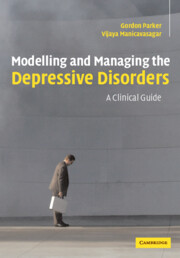Book contents
- Frontmatter
- Contents
- Acknowledgements
- Introduction
- Part I The current model for depressive disorders and its impact on clinical management
- Part II The diagnosis and management of melancholic and psychotic depression
- Part III An introduction to non-melancholic depression
- Part IV Modelling and managing the non-melancholic depressive disorders
- 13 Acute stress-related non-melancholic depression
- 14 Acute stress-related non-melancholic depression: ‘key and lock’ model
- 15 Chronic stress-related non-melancholic depression
- 16 The perfectionist personality style and non-melancholic depression
- 17 Irritability and non-melancholic depression
- 18 Anxious worrying and non-melancholic depression
- 19 Social avoidance and non-melancholic depression
- 20 Personal reserve and non-melancholic depression
- 21 Rejection sensitivity and non-melancholic depression
- 22 Self-focused personality style and non-melancholic depression
- 23 Self-criticism and non-melancholic depression
- 24 Natural and alternative treatments for non-melancholic depression
- Appendix 1 The DMI-18 and the DMI-10
- Appendix 2 The CORE system of measuring psychomotor disturbance
- Appendix 3 The temperament and personality measure
- References
- Index
18 - Anxious worrying and non-melancholic depression
from Part IV - Modelling and managing the non-melancholic depressive disorders
Published online by Cambridge University Press: 17 August 2009
- Frontmatter
- Contents
- Acknowledgements
- Introduction
- Part I The current model for depressive disorders and its impact on clinical management
- Part II The diagnosis and management of melancholic and psychotic depression
- Part III An introduction to non-melancholic depression
- Part IV Modelling and managing the non-melancholic depressive disorders
- 13 Acute stress-related non-melancholic depression
- 14 Acute stress-related non-melancholic depression: ‘key and lock’ model
- 15 Chronic stress-related non-melancholic depression
- 16 The perfectionist personality style and non-melancholic depression
- 17 Irritability and non-melancholic depression
- 18 Anxious worrying and non-melancholic depression
- 19 Social avoidance and non-melancholic depression
- 20 Personal reserve and non-melancholic depression
- 21 Rejection sensitivity and non-melancholic depression
- 22 Self-focused personality style and non-melancholic depression
- 23 Self-criticism and non-melancholic depression
- 24 Natural and alternative treatments for non-melancholic depression
- Appendix 1 The DMI-18 and the DMI-10
- Appendix 2 The CORE system of measuring psychomotor disturbance
- Appendix 3 The temperament and personality measure
- References
- Index
Summary
Anxious worrying style
While many people experience periods of worry in their lives, those with an anxious worrying temperament have a tendency to worry most of the time, seemingly over the most trivial incidents and situations. They are often described by others as being ‘highly strung’ or ‘nervy’. Domains of anxiety may include worrying that the worst will happen even after minor events, being especially sensitive about unexpected changes in their immediate environment, and getting upset over minor things that go wrong. People with this type of temperament are easily upset and stressed, and can seem tense and jumpy. When distressed, they tend to find comfort in talking to close friends about their worries and in seeking reassurance, or going quiet and keeping to themselves. Sometimes they may resort to temporary relief from their worries by engaging in pleasurable activities as a means of distraction.
Key characteristics of the Anxious Worrying Temperament (derived from our Temperament and Personality Questionnaire):
High levels of autonomous arousal.
Easily rattled and upset.
Tense and nervy.
Worry over minor things.
Take things too personally.
Worry that the worst will happen.
When stressed, key personality features of the anxious worrier, such as ruminative and catastrophic thoughts, worsen. When such thoughts begin to focus on excessive self-doubt, and pessimism about the future, together with a sense of ineffectiveness or helplessness, a depressive episode may arise.
- Type
- Chapter
- Information
- Modelling and Managing the Depressive DisordersA Clinical Guide, pp. 154 - 163Publisher: Cambridge University PressPrint publication year: 2005

